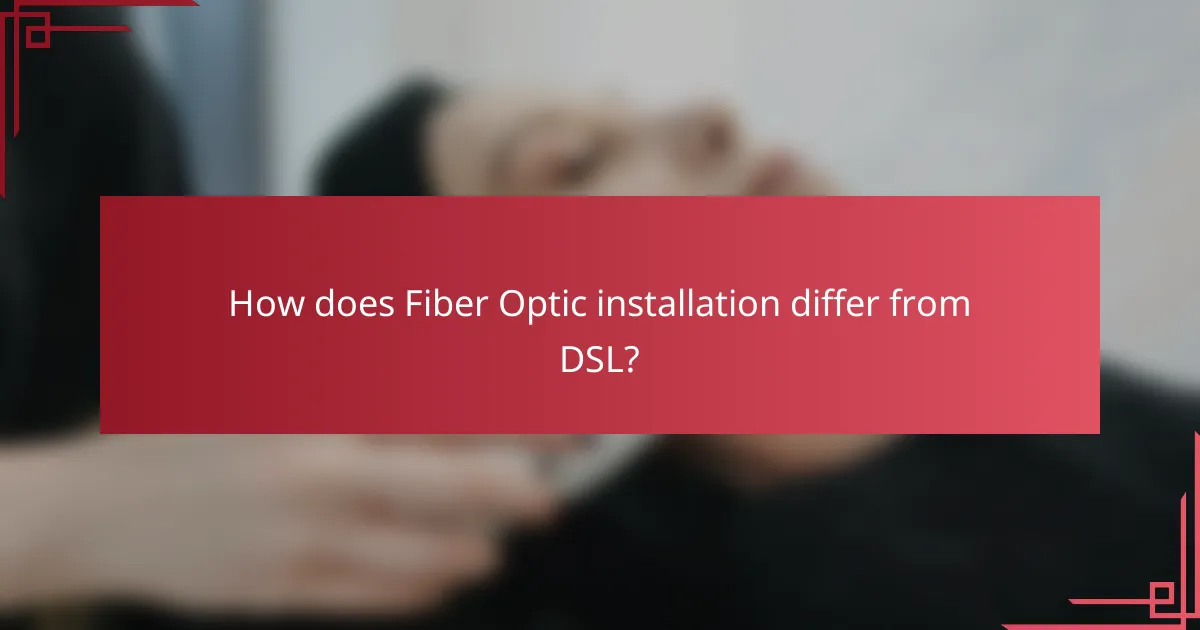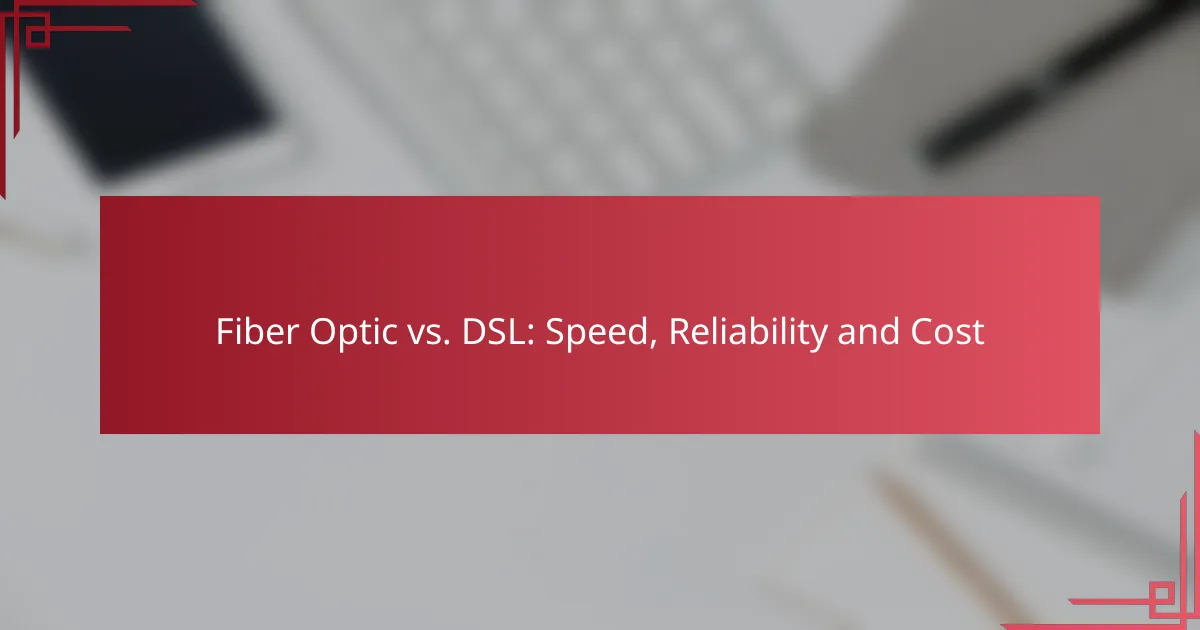When comparing Fiber Optic and DSL internet, speed, reliability, and cost are key factors to consider. Fiber optic technology typically offers much faster speeds and greater reliability, while DSL may be more affordable but is limited in performance and can be affected by distance and environmental factors. Understanding these differences can help consumers make informed decisions based on their specific needs and budget.

Which is faster: Fiber Optic or DSL?
Fiber optic internet is generally faster than DSL, offering significantly higher maximum speeds. While DSL can deliver decent speeds, its performance is limited compared to the capabilities of fiber optic technology.
Fiber Optic offers higher maximum speeds
Fiber optic connections can provide speeds that exceed 1 Gbps, making them ideal for high-demand activities such as streaming, gaming, and large file transfers. This technology uses light signals to transmit data, resulting in faster and more efficient communication.
Many fiber optic providers offer plans with varying maximum speeds, often ranging from hundreds of Mbps to several Gbps. This flexibility allows consumers to choose a plan that best suits their internet usage needs.
DSL speeds vary based on distance from the provider
DSL speeds are heavily influenced by the distance between the user’s location and the service provider’s central office. Generally, the farther you are from the provider, the slower your internet speed will be, often dropping to low Mbps or even lower.
For example, users located within a mile of the provider may experience speeds up to 100 Mbps, while those several miles away might see speeds reduced to 10 Mbps or less. This variability makes DSL less reliable for users in rural or remote areas.

How reliable are Fiber Optic and DSL connections?
Fiber optic connections are generally more reliable than DSL connections, offering lower latency and fewer outages. DSL can experience disruptions due to environmental factors and distance from the service provider.
Fiber Optic has lower latency and fewer outages
Fiber optic technology transmits data using light signals, resulting in lower latency compared to DSL, which relies on electrical signals over copper lines. This means that fiber optic connections can provide faster response times, making them ideal for activities like online gaming and video conferencing.
Additionally, fiber optic networks are less susceptible to outages. They are designed to handle higher bandwidth and are not affected by electromagnetic interference, which can disrupt DSL connections. As a result, users can expect more consistent performance with fiber optics.
DSL can be affected by weather and distance
DSL connections can experience issues due to weather conditions such as heavy rain or storms, which can degrade signal quality. Moreover, the distance from the service provider’s central office plays a significant role in DSL performance; the farther you are, the weaker the signal, leading to slower speeds and increased latency.
For users considering DSL, it’s important to check the distance from the nearest service point and be aware that performance may vary significantly based on local conditions. In some cases, users may find that their DSL speeds drop to a fraction of the advertised rates, especially during adverse weather or peak usage times.

What are the costs associated with Fiber Optic and DSL?
The costs of Fiber Optic and DSL services vary significantly, impacting installation and monthly fees. Fiber Optic generally involves higher upfront installation costs, while DSL plans tend to be more budget-friendly for consumers.
Fiber Optic typically has higher installation costs
Installing Fiber Optic internet can be expensive, often ranging from several hundred to over a thousand dollars, depending on the complexity of the installation and the provider. This is due to the advanced technology and materials required to lay fiber cables, which may involve digging and extensive labor.
Additionally, some providers may charge installation fees that are not included in the monthly service rate. Consumers should inquire about any potential hidden costs and consider whether the long-term benefits of higher speeds justify the initial investment.
DSL plans are generally more affordable
DSL internet plans are typically more affordable, with monthly fees often ranging from $20 to $60, making them accessible for many households. The lower installation costs, usually around $50 to $100, contribute to this affordability.
However, while DSL may be cheaper, it often offers slower speeds compared to Fiber Optic. Consumers should weigh the cost savings against their internet usage needs to determine if DSL is the right choice for them.

What factors should I consider when choosing between Fiber Optic and DSL?
When choosing between Fiber Optic and DSL, consider factors such as availability, required internet speed, reliability, and cost. Each option has distinct advantages and limitations that can significantly impact your internet experience.
Availability in your area
Availability is a crucial factor when selecting between Fiber Optic and DSL. Fiber Optic service is often limited to urban and suburban areas, while DSL can reach more rural locations due to its reliance on existing telephone lines. Check with local providers to see which options are accessible in your specific area.
To determine availability, visit the websites of major internet service providers or use online tools that allow you to enter your address for service options. This will help you understand what is realistically attainable in your location.
Required internet speed for your needs
Your internet speed requirements play a significant role in choosing between Fiber Optic and DSL. Fiber Optic typically offers much higher speeds, often ranging from 100 Mbps to 1 Gbps, making it ideal for households with multiple users or heavy data needs like streaming and gaming. In contrast, DSL speeds generally range from 1 to 100 Mbps, which may suffice for basic browsing and streaming on a single device.
Consider your usage patterns: if you frequently download large files, stream high-definition content, or have several devices connected simultaneously, Fiber Optic is likely the better choice. Conversely, if your internet use is minimal, DSL may meet your needs at a lower cost.

How does Fiber Optic installation differ from DSL?
Fiber optic installation typically requires more specialized equipment and infrastructure compared to DSL, which utilizes existing telephone lines. This difference impacts the installation process, time, and overall cost for consumers.
Fiber Optic requires specialized equipment
Installing fiber optic internet involves advanced technology, including fiber cables, connectors, and optical network terminals. This equipment is essential for transmitting data at high speeds over long distances.
Due to the need for specialized tools and trained technicians, fiber optic installations can take longer and may incur higher upfront costs. However, the investment often pays off with faster speeds and greater reliability in the long run.
DSL uses existing telephone lines
DSL technology leverages the existing copper telephone lines, making installation simpler and generally quicker. Since the infrastructure is already in place, providers can often activate service with minimal setup.
This reliance on established lines means that DSL can be a more cost-effective option for consumers, especially in areas where fiber optic networks are not yet available. However, the speeds and reliability of DSL can be limited compared to fiber optic connections.

What are the advantages of Fiber Optic over DSL?
Fiber optic internet offers significant advantages over DSL, particularly in terms of speed, reliability, and capacity. It provides faster data transmission rates and is less susceptible to interference, making it a superior choice for high-demand users.
Better performance for multiple users
Fiber optic technology excels in environments with multiple users, delivering consistent high speeds even during peak usage times. Unlike DSL, which can slow down as more devices connect, fiber maintains its performance due to its higher bandwidth capacity.
This means households or offices with several devices streaming, gaming, or working online can experience seamless connectivity. For example, fiber can support dozens of simultaneous users without noticeable degradation in speed.
Future-proof technology
Fiber optic networks are designed to handle increasing data demands, making them a future-proof option. As internet usage continues to grow with advancements in technology, fiber can easily accommodate higher speeds and larger data volumes without the need for extensive upgrades.
In contrast, DSL technology is limited by its copper wiring, which cannot support the same level of growth. Investing in fiber now can save costs in the long run, as it is likely to remain relevant for many years to come.

What are the disadvantages of Fiber Optic compared to DSL?
Fiber optic internet has several disadvantages compared to DSL, primarily related to cost and availability. While fiber offers superior speed and reliability, the initial investment and accessibility can be significant drawbacks for many users.
Higher initial investment
One of the main disadvantages of fiber optic internet is the higher initial investment required for installation. The cost of laying fiber optic cables can be substantially more than setting up DSL, often ranging from hundreds to thousands of dollars depending on the location and infrastructure needed.
Additionally, service providers may charge higher monthly fees for fiber plans compared to DSL options. This can make fiber less appealing for budget-conscious consumers who prioritize lower upfront costs over speed and reliability.
Limited availability in rural areas
Fiber optic internet is often not available in rural areas, which can limit access for many potential users. While DSL can reach more remote locations due to existing telephone lines, fiber infrastructure is typically concentrated in urban and suburban regions.
This limited availability means that consumers in rural areas may have to settle for slower DSL speeds or other alternatives, which can impact their internet experience. It’s essential for users to check local service availability before making a decision on their internet provider.

How can I find the best internet provider for Fiber Optic or DSL?
To find the best internet provider for Fiber Optic or DSL, start by comparing the available options in your area. Consider factors such as speed, reliability, and cost, as well as customer reviews and service quality.
Compare local providers like AT&T and Comcast
When comparing local providers such as AT&T and Comcast, evaluate their service offerings based on speed and reliability. AT&T typically offers higher speeds with fiber optic connections, while Comcast may provide more widespread DSL options in certain regions.
Check the plans available in your area, as they can vary significantly. For example, AT&T’s fiber plans may offer speeds up to 1 Gbps, while Comcast’s DSL options might range from 25 to 100 Mbps, depending on the package.
Additionally, consider customer service ratings and contract terms. Look for providers with flexible contracts and favorable cancellation policies to avoid long-term commitments that may not suit your needs.



